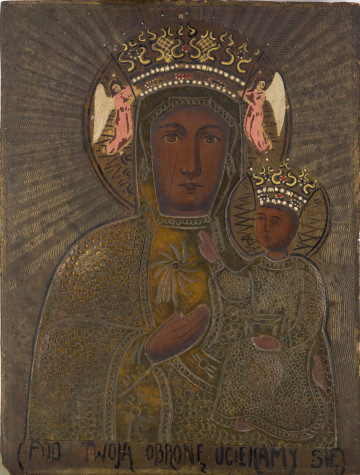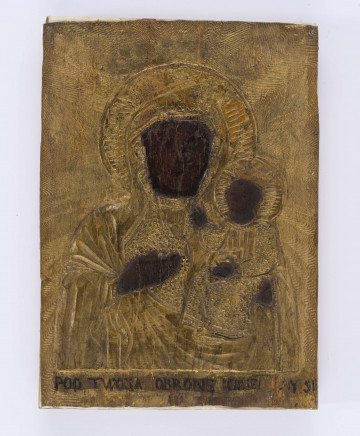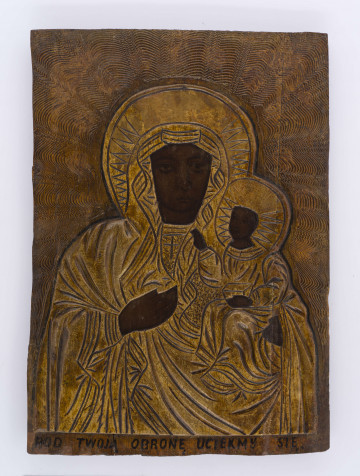
Black Madonna of Częstochowa
1890 — 1910
National Museum in Lublin
Part of the collection: Folk Art of the Lublin Region (17th–1st half of the 20th c.)
The cult of holy images spread in the 17th century. It was influenced by the many apparitions announced at that time, and thus the construction of new sanctuaries or monasteries and the increased number of indulgence feasts and pilgrimages. Craft workshops were established at the monasteries, creating and distributing miraculous Marian images. The most important for folk devotional painting were workshops in Częstochowa, concentrated around the Jasna Góra monastery. From 1621, after the synod of Kraków, it was recommended to the faithful to venerate the images of the Virgin Mary and patron saints. According to the guidelines, the images were to be like the originals, and the monastery was to control the conformity with the original. However, among the first correct works of painters, who probably came from the guild workshops of Kraków and Silesia, there were paintings made by the so-called "bunglers", on which "monsters rather than faces of the Blessed Virgin and other saints were expressed". In time, in 1718, at the request of the Order, a congregation of painters was established and a guild of about thirty workshops was organised. Apart from defining the statute and journeyman regulations, the function of a censor was introduced.
The Czestochowa workshops offered pilgrims a great variety of subjects. These were: Marian images - the Virgin Mary of Częstochowa, the Feeding Mother of God, and Christological themes - the Crucifixion in several variants, Christ in the Tomb, the Holy Trinity, the Holy Family, the Eye of Providence. There was a wide range of representations of saints and patron saints: St Anne, St Barbara, St Mary Magdalene. During pilgrimages to Jasna Góra, paintings were bought at Częstochowa stalls. At local fairs and indulgence feasts, they were also sold by itinerant traders, known as "picture-makers". They were highly respected and given as a gift.
Our Lady of Czestochowa is the most important Marian image in Poland. Since 1382, when she appeared in the monastery as a gift from Duke Vladislaus II of Opole, she has been regarded by Poles as the Queen of Poland. The source of the models for her first images were the graphics published in the publications prepared by the Pauline Fathers of Jasna Góra. While painting them, realism was preserved only in the parts of the face and hands, the robes and decorations were painted without chiaroscuro, yet richly decorated.
Author / creator
Dimensions
cały obiekt: height: 34 cm, width: 44,5 cm
Object type
painting
Technique
combing
Material
plank, oil-based paint, adhesive and chalk mortar
Creation time / dating
Creation / finding place
Owner
The National Museum in Lublin
Identification number
Location / status

1890 — 1910
National Museum in Lublin

1901 — 1920
National Museum in Lublin

1880 — 1910
National Museum in Lublin
DISCOVER this TOPIC
Castle Museum in Łańcut
DISCOVER this PATH
Educational path